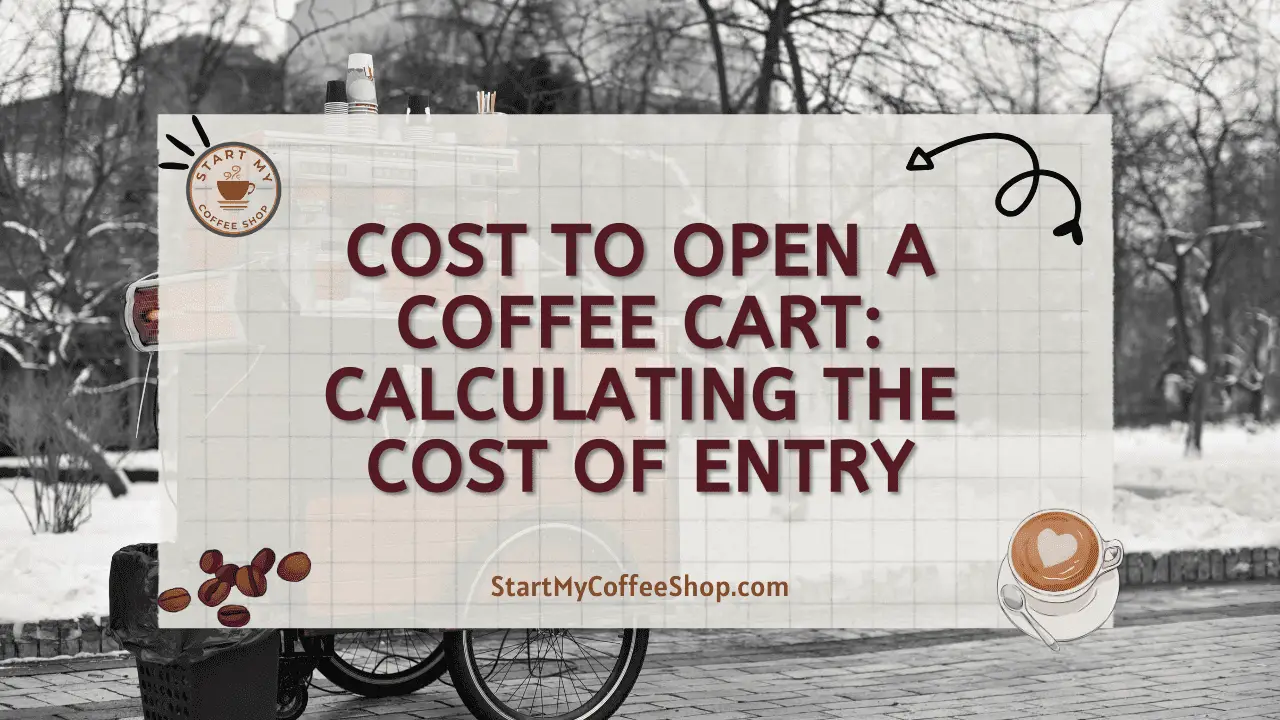Coffee carts have become increasingly popular in recent years, offering a convenient and mobile way to serve delicious coffee to customers. If you’re passionate about coffee and dream of running your own business, opening a coffee cart might be an excellent option. However, before embarking on this entrepreneurial journey, it’s crucial to understand the costs involved.
Discovering the cost to open a coffee cart is crucial for aspiring entrepreneurs. From carts and equipment to licenses, supplies, and staffing, budgeting around $15,000 to $40,000 is necessary. Plan wisely to turn your coffee cart dream into a thriving reality.
In this article, I will provide a comprehensive breakdown of the expenses associated with opening a coffee cart, enabling you to plan and budget effectively.
Cart and Equipment Costs

The first major expense when starting a coffee cart is the purchase of the cart itself. The cost of a coffee cart can vary significantly depending on factors such as size, design, and customization. On average, a new coffee cart can range from $5,000 to $20,000. However, it’s also possible to find used carts at a lower price, but caution is advised to thoroughly inspect them before making a purchase.
Apart from the cart, there is a need to acquire essential equipment to ensure the smooth operation of your coffee cart business. These equipment items include an espresso machine, grinder, blender, refrigeration units, and storage containers. The cost of these equipment items can vary depending on your preferences and the quality of the equipment. On average, budgeting around $5,000 to $10,000 for these essential equipment expenses is a reasonable estimate.
When purchasing the cart and equipment, it’s essential to strike a balance between quality and affordability. Consider the durability and functionality of the cart and equipment to ensure they meet your specific needs. It may be tempting to go for the lowest-priced option, but investing in high-quality equipment will save you from potential repair or replacement costs down the line.
Additionally, it’s advisable to research reputable suppliers and compare prices to get the best value for your money. Look for suppliers who offer warranties or after-sales support to provide you with peace of mind and assistance in case of any issues with the purchased items.
Keep in mind that the cost of the cart and equipment is just the beginning. There are several other expenses to consider when opening a coffee cart. Licenses and permits are requirement for operating a coffee cart. The specific permits and licenses needed can vary depending on your location. Health permits, food handlers’ permits, and business permits are commonly required. These licenses and permits can cost anywhere from $500 to $2,000, depending on local regulations.
In addition to licenses and permits, there are ongoing operational expenses to consider. Rent or parking fees may be necessary if you plan to set up your coffee cart in a high-foot-traffic area. The prices for rent or parking fees can vary significantly depending on the location, ranging from $500 to $1,500 per month.
Utilities such as electricity, water, and possibly propane (if applicable) are also part of the operating expenses. Plan to allocate approximately $100 to $300 per month for these utilities.
Furthermore, budgeting for supplies and inventory is essential. This includes coffee beans, milk, syrups, cups, lids, stirrers, napkins, and other consumables. The amount of inventory needed will depend on your projected sales volume and customer demand. Allocating around $1,000 to $2,000 for initial supplies is a reasonable estimate.
Marketing and advertising costs should also be factored into your budget. Investing in marketing initiatives to attract customers is crucial for the progress of your coffee cart business. This can include social media campaigns, local promotions, and signage. Plan to set aside approximately $200 to $500 per month for marketing and advertising efforts.
As your coffee cart business grows, you may need to hire employees to assist with operations. Staffing costs will include wages, taxes, and potential benefits. Depending on the number of employees and the hours they work, staffing expenses can range from $1,500 to $4,000 per month.
Read more about: Cost of Green Coffee Beans: The Hidden Value
Licenses and Permits
When venturing into the world of operating a coffee cart, it’s essential to navigate the realm of licenses and permits. The specific licenses and permits required can vary depending on your location, as regulations differ from one jurisdiction to another. However, some common permits are typically necessary for operating a coffee cart.
Health permits are an essential requirement for ensuring that your coffee cart operates safely and hygienically. These permits demonstrate that you comply with local health regulations and have taken the necessary precautions to protect the health of your customers. The cost of a health permit can range from $100 to $500, depending on the location and the size of your operation.
Food handlers permit is another crucial component when serving food and beverages from your coffee cart. These permits are typically required to demonstrate that you and your employees have undergone proper training in handling food safely. The cost of a food handler’s permit can vary, typically ranging from $50 to $200 per person, depending on the jurisdiction.
Business permits are necessary to legally operate your coffee cart as a business entity. These permits ensure that you comply with local business regulations and zoning ordinances. The cost of a business permit can range from $100 to $500 or more, depending on your location and the type of business entity you establish.
In addition to these common permits, there may be additional licenses or permits required based on specific factors. For example, if you plan to serve alcoholic beverages from your coffee cart, you may need to obtain a separate liquor license, which can involve additional costs and requirements.
It’s important to research and understand the licensing requirements specific to your location. Contact your local government offices or regulatory agencies to gather information about the necessary permits and the associated costs. It’s also advisable to consult with professionals, such as lawyers or business consultants, who can guide you through the licensing process and ensure compliance with all relevant regulations.
Keep in mind that the costs associated with licenses and permits can vary widely depending on your location and the complexity of the permitting process. It’s crucial to allocate a budget of approximately $500 to $2,000 for licenses and permits when planning to open a coffee cart. However, these estimates are just a starting point, and it’s essential to conduct thorough research and budget accordingly to account for any specific requirements or fees in your area.
Remember that obtaining the necessary licenses and permits is not only a legal requirement but also ensures that you operate your coffee cart business ethically and responsibly. Compliance with health and safety regulations protects both your customers and your business’s reputation. Make sure to renew your permits as required and stay up to date with any changes in regulations that may affect your operations.
By understanding the licensing and permitting process and budgeting accordingly, you can ensure that your coffee cart business operates within the legal framework and provides a safe and enjoyable experience for your customers.
Supplies and Inventory
When it comes to operating a coffee cart, having a well-stocked inventory is essential to meet the demands of your customers and provide them with a delightful coffee experience. Purchasing initial supplies and inventory requires careful planning and budgeting to ensure a smooth start to your business.
The list of initial supplies for your coffee cart includes coffee beans, milk, syrups, cups, lids, stirrers, napkins, and other consumables. The specific quantities and types of supplies you’ll need depend on factors such as your projected sales volume and the variety of beverages you plan to offer.
Coffee beans are the heart and soul of your coffee cart, so it’s crucial to source high-quality beans that align with your desired flavor profiles. The cost of coffee beans can vary based on factors such as origin, quality, and brand. Depending on your projected sales volume, budgeting around $200 to $500 for coffee beans for the first month is a reasonable estimate.
Milk is another essential ingredient for a variety of coffee-based beverages. The cost of milk will depend on factors such as the type (whole, skim, almond, etc.) and the volume you anticipate using. Budgeting around $100 to $300 for milk supplies for the first month should be sufficient, but this may vary depending on your sales volume.
Syrups are popular additions to coffee beverages, allowing customers to customize their drinks with various flavors. The cost of syrups depends on the variety and brand you choose. It’s advisable to start with a selection of popular flavors and budget approximately $100 to $200 for syrups for the initial month.
Cups, lids, stirrers, and napkins are essential for serving your beverages and ensuring a convenient experience for your customers. The quantity of these items will depend on your projected sales volume and the frequency of restocking. It’s wise to budget around $200 to $400 for these consumables for the first month.
In addition to these specific supplies, consider other items you may need for your coffee carts, such as sugar packets, sweeteners, creamers, and condiments. The cost for these additional items can vary depending on your preferences and the quantities required.
Remember, these estimates are meant to provide a starting point for your budgeting process. It’s crucial to assess your specific business needs, projected sales volume, and pricing in your area to create an accurate budget for your initial supplies and inventory.
To optimize your inventory management and minimize waste, it’s essential to track your sales and adjust your purchasing accordingly. As you gain insights into your customers’ preferences and demand patterns, you can fine-tune your inventory to optimize efficiency and minimize unnecessary expenses.
Maintaining good relationships with suppliers is also crucial. Explore options for bulk purchasing or establishing relationships with local vendors to potentially secure better pricing and discounts. This can help reduce costs and increase profitability over time.
Read more about: Cost of Opening a Coffee Bar: Some Beans and Bills
Operating Expenses

Running a coffee cart involves a range of ongoing expenses that must be considered when creating a comprehensive budget. These expenses play a crucial role in the day-to-day operation and growth of your business.
Here are some common operating expenses to factor into your financial plan:
- Rent or Parking Fees: One of the primary expenses to consider is the cost of rent or parking fees for your coffee cart’s location. The price can vary significantly depending on the popularity and foot traffic of the area. In high-traffic locations, the rent or parking fees may range from $500 to $1,500 per month. It’s important to find a balance between a desirable location and reasonable expenses to ensure profitability.
- Utilities: Another ongoing expense to account for is the cost of utilities necessary for running your coffee cart. These utilities typically include electricity, water, and propane (if applicable). On average, expect to allocate around $100 to $300 per month to cover these expenses. Monitoring your energy usage and adopting energy-efficient practices can help reduce costs over time.
- Ingredients and Supplies: Regularly restocking your inventory is crucial to maintain a steady supply of coffee beans, milk, syrups, and other consumables. The frequency and cost of restocking will depend on the volume of sales and customer demand. On average, monthly expenses for ingredients and supplies can range from $500 to $1,000. It’s essential to monitor sales trends and adjust your purchasing accordingly to minimize waste and maximize efficiency.
- Marketing and Advertising: Allocating a portion of your budget for marketing and advertising initiatives is essential to attract customers and promote your coffee cart. Consider investing in social media campaigns, local promotions, and eye-catching signage to increase visibility. Depending on the scale and scope of your marketing efforts, setting aside around $200 to $500 per month is a reasonable estimate. By continuously engaging with your target audience and leveraging various marketing channels, you can build brand awareness and attract a loyal customer base.
It’s worth noting that these operating expenses can vary based on several factors, including the location of your coffee cart, the size of your business, and the specific requirements of your operation. Therefore, it’s crucial to regularly review and adjust your budget as needed to reflect changes in expenses.
To optimize your finances, consider implementing cost-saving strategies. For example, exploring potential discounts or bulk purchasing options for ingredients and supplies can help reduce expenses. Additionally, monitoring and adjusting energy consumption and exploring energy-efficient equipment can lead to long-term savings on utility bills.
Regularly reviewing your expenses, comparing prices from different suppliers, and seeking opportunities for cost optimization will contribute to the financial stability and improvement of your coffee cart business. By maintaining a balanced approach between cost management and delivering quality products, you can position your coffee cart for sustainable growth in a competitive market.
Staffing Costs
As your coffee cart business expands and customer demand increases, it may become necessary to hire employees to assist with the day-to-day operations. Staffing costs are a significant consideration, encompassing wages, taxes, and potential benefits. It’s essential to carefully plan and budget for these expenses to ensure smooth operations and a productive workforce.
When determining staffing costs, several factors come into play, including the number of employees you need and the number of hours they will work. Consider the various roles required, such as baristas, cashiers, and assistants, and the appropriate number of staff members to efficiently handle the workload.
Wages form a substantial portion of your staffing costs. The amount you pay employees will depend on factors such as their experience, skill level, and local labor market conditions. It’s crucial to adhere to minimum wage laws and provide fair compensation to attract and retain talented individuals. On average, wages for coffee cart employees can range from $10 to $15 per hour. Calculate the total number of hours worked by your employees each month and multiply it by the average wage to estimate your monthly staffing expenses.
In addition to wages, you’ll also need to consider taxes and other related expenses. These costs typically include employer taxes, such as Social Security, Medicare, and unemployment insurance. The specific tax rates and requirements may vary depending on your location. It’s advisable to consult with a tax professional or accountant to ensure compliance with all applicable regulations and accurately calculate your tax obligations.
Furthermore, you may choose to offer benefits to your employees, such as health insurance, retirement plans, or paid time off. Providing benefits can help attract and retain high-quality staff members, contributing to the long-term growth of your coffee cart business. The cost of benefits will depend on the specific offerings and the number of employees eligible for them. Budgeting around 20-30% of your total payroll costs for benefits is a general guideline.
Overall, staffing costs can range from $1,500 to $4,000 per month, depending on the number of employees, their wages, and any additional expenses related to taxes and benefits. It’s crucial to regularly assess your labor needs and adjust your staffing levels as your business evolves. Hiring part-time employees or exploring shared staffing arrangements with neighboring businesses can be cost-effective solutions to manage staffing costs during slower periods.
To optimize your staffing expenses, consider implementing efficient scheduling practices to ensure proper coverage during peak hours while minimizing unnecessary labor costs during quieter times. Cross-training your employees to handle multiple tasks can also help increase flexibility and productivity.
Moreover, fostering a positive work environment, providing ongoing training and development opportunities, and recognizing and rewarding employee achievements can enhance employee satisfaction and productivity, leading to improved customer service and business growth.
Properly managing your staffing costs is crucial to maintaining a healthy financial position and sustaining your coffee cart business over the long term. By carefully budgeting for wages, taxes, and benefits, and making strategic decisions regarding staffing levels and scheduling, you can build a capable and motivated team that supports the achievement of your coffee cart venture.
Read more about: Cost of Green Coffee Beans: The Hidden Value
Summary
Opening a coffee cart can be an exciting venture, but it’s essential to be aware of the costs involved. The initial investment for a coffee cart, equipment, licenses, and permits can add up to around $15,000 to $40,000. Additionally, operating expenses, supplies, and staffing costs will require ongoing budgeting and planning.
By understanding the financial requirements of starting a coffee cart, you can create a realistic business plan and avoid any financial surprises along the way. Remember, careful planning and diligent research will set you on the path to a great coffee cart business. So, brew up your passion, calculate the costs, and make your dream of running a coffee cart a reality!
Frequently Asked Questions
Q: What licenses and permits are required to operate a coffee cart?
Operating a coffee cart requires obtaining licenses and permits such as health permits, food handlers’ permits, and business permits. The specific requirements vary by location, so it’s essential to research and comply with local regulations.
Q: How much inventory should I budget for?
It’s wise to budget around $1,000 to $2,000 for initial supplies, including coffee beans, milk, syrups, cups, lids, and other consumables.
Q: Are there ongoing expenses to consider?
Yes. These can include rent or parking fees, utilities (electricity, water, propane), regular inventory replenishment, marketing and advertising costs, and staffing expenses.
To learn more on how to start your own coffee shop, check out my startup documents here.
Disclaimer: The information provided by StartMyCoffeeShop.com (“The Site”) is for general informational purposes only. All information on the Site is provided in good faith. However, we make no representation or warranty of any kind, express or implied, regarding the accuracy, adequacy, validity, reliability, availability, or completeness of any information on the Site. Under no circumstance shall we have any liability to you for any loss or damage of any kind incurred as a result of the use of the Site or Reliance on any information provided on the Site. Your use of the Site and reliance on any information on the Site is solely at your own risk. This blog post is for educational purposes only and does not constitute legal advice. Please consult a legal expert to address your specific needs. Terms and Conditions. (https://startmycoffeeshop.com/terms-and-conditions/)

Hi! I’m Shawn Chun
My adventure in coffee began when I first launched my first coffee shop back in the early 2000s. I had to figure out so many things on my own and to make it worse within 2 years of opening two large corporate coffee chains moved in just blocks away from me!
As I saw smaller and even some larger coffee shops in the neighborhood slowly lose customers to these giant coffee chains and slowly close up shop, I knew that I had to start getting creative…or go out of business.
I (like you may be) knew the coffee industry well. I could make the best latte art around and the foam on my caps was the fluffiest you have ever seen. I even had the best state-of-the-art 2 group digital Nuova Simonelli machine money could buy. But I knew that these things alone would not be enough to lure customers away from the name brand established coffee shops.
Eventually, through lots of trial and error as well as perseverance and creativity I did find a way to not only survive but also thrive in the coffee/espresso industry even while those corporate coffee chains stayed put. During those years I learned to adapt and always faced new challenges. It was not always easy, however, in the end, I was the sole survivor independent coffee shop within a 10-mile radius of my location. Just two corporate coffee chains and I were left after that year. All told the corporate coffee chains took down over 15 small independent coffee shops and kiosks and I was the last one standing and thriving.
Along the years I meet others with the same passion for coffee and I quickly learned that it is not only “how good a barista is” that makes a coffee shop successful, but the business side of coffee as well.
Hence why I started this website you are on now. To provide the tools and resources for up and coming coffee shop owners to gain that vital insight and knowledge on how to start a coffee shop successfully.
Stick around, browse through my helpful blog and resources and enjoy your stay! With lots of LATTE LOVE!
Shawn






